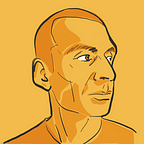Function, Feel, Form
“Most people make the mistake of thinking design is what it looks like. People think it’s this veneer — that the designers are handed this box and told, ‘Make it look good!’ That’s not what we think design is. It’s not just what it looks like and feels like. Design is how it works.”
— Steve Jobs
Making high-quality interactive experiences have always involved sequencing of function, feel and form. Designers and technologists have often built prototypes of small portions of products to see what works and what doesn’t.
In recent years, the improved usability of prototyping tools has allowed more people to create more fully-realistic experiences which can be built in a relatively short period of time. Both designers and users are able to see a high fidelity interpretation of what might eventually get made.
With these new tools, prototypes have become a blend of the three core elements of function, feel and form. While this might seem optimal, in reality, this melding often produces results that do not fully explore any one of those core areas. This lack of focus can lead to ideas being executed too quickly, with less than desirable results. As designers, we need to understand what it means to prototype for these three areas so we can refine each to make more coherent designs.
Function (Flow + features)
The function helps us see the inner working of an idea; it reveals an idea’s basic nature and allows us to satisfy the primary product use. For example, a skeleton of a car can still serve to move you from place to place.
Feel (Interaction)
What is the tactile quality and emotion you feel when you pick something up for the first time? Feel helps us understand much of what is unsaid: does feeling soft, hard, hollow or solid make a product feel satisfying, familiar, approachable? In both the physical world and the digital, much experimentation is needed before an idea “feels” right.
Form (Language + Interface)
What strikes you when you look at a fully executed idea? How does the visual form or language change your relationship to using the product or service? Form often guides how a particular idea connects with how we see ourselves and our taste. For example, in a sea of black headphones Beats headphones come in multiple colors and connect with popular culture and the desire for individuality even though they are mass-produced.
It’s useful to look at industrial design, which has extensively used prototyping that splits apart the three ideas, treating them as distinct parts of the overall concept.
An industrial designer would never initially try to address all three facets in the same prototype because too many concessions would have to be made in the manufacturing of the prototype. Take, for example, a cell phone: To make the electronics necessary without mass manufacture the electronics would be too large to create the right form and feel for the prototype. Making three separate prototypes makes it easier to explore each of these core areas in more detail.
- A simple but functional prototype which can test the core feature set and make sure they work at a basic level.
- A number of prototypes made from different materials to explore the possibilities of feel.
- A simple and elegant solid model of the phone to see its form to understand its aesthetic value.
Splitting the process into core elements allows it to move more quickly while allowing for a deeper exploration of each core element of the design. As the design process moves through the initial phase, the function, feel and form are fused together into more and more elaborate prototypes. Yet still, at any stage in the journey, it might be necessary to decouple a single core element (Function, Feel or Form) to try out a new idea without having to stop the progress of the overall design and production process.
In the digital world, some physical realities do not apply but can be reinterpreted in conceptual and workflow ways. If from the outset of a project you are constantly trying to make something look pixel perfect while testing its function you will compromise both function and form, and take twice as long doing it.
So what does this all mean? Do you need to build three different prototypes every time you want to make a digital product? I think the answer is NO; yet, you do need to be ready to quickly create additional prototypes during any phase of the design process. You do this to see how the core elements of Function, Feel and Form effect your overall design so that you can integrate the results into your main prototype process. Today we have better tools than ever to quickly make and test ideas in any one of the three core areas, so why not do just that? Branch off when it makes sense and then bring it all back together quickly and efficiently.
As new platforms and forms of interaction become mainstream, like voice & chat interfaces or augmented / virtual reality, the principles of function, feel and form actually become even more important. When the interface for a product or service is not readily apparent, as, in the case of voice interfaces, it is important to understand the functional elements, the feel cues for a conversation, and the form of the language used to help the user understand the nature of the interaction and activity.
Working more quickly and focusing your efforts on each of the core elements allows you to make the best thing instead of just the next thing.
Thanks for reading! :) If you enjoyed it, hit that clap button below. It would mean a lot to me and it helps other people see the story.
ABOUT DESIGN + CULTURE
Articles and collections at the intersection of Design + Culture
Design + Culture Archive
Design + Culture Sign up
